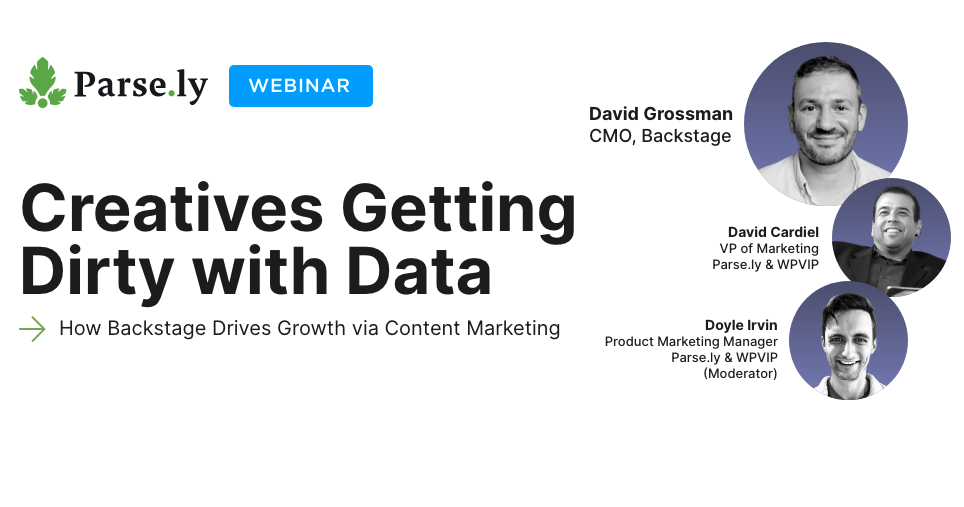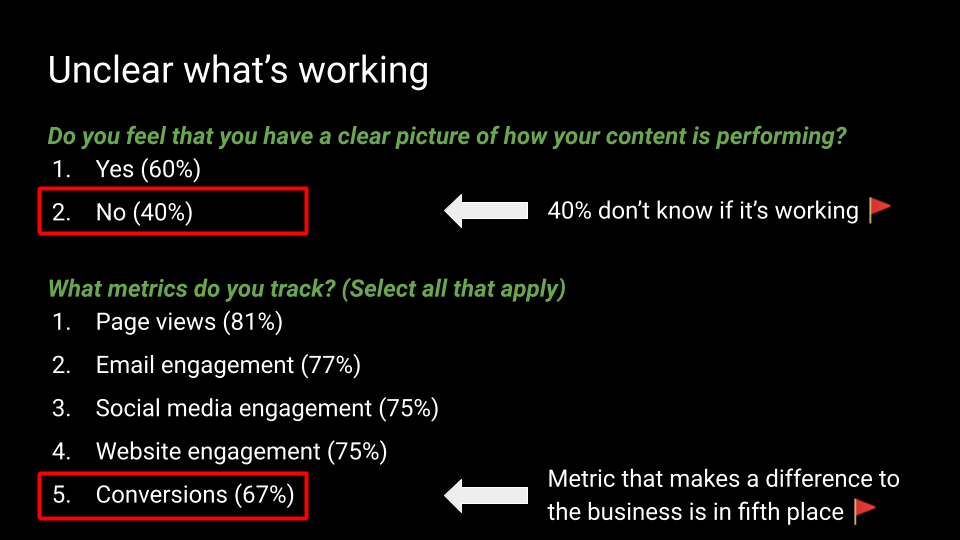Creatives Getting Dirty With Data: How Backstage Drives Growth Via Content Marketing | Webinar Recap

The past two years have been a true test of businesses’ ability to thrive in a world of uncertainty, and the ones with the best content were the ones that came out on top.
Backstage was certainly one of those who came out on top, growing their platform into the premier platform for staffing creative talent by using a data-driven content marketing strategy.
In last week’s webinar, David Grossman, CMO of Backstage, walked us through how they used Parse.ly to achieve a 20% increase in conversions, 25% revenue growth attributable to content marketing, and 10% savings on ad spend. Here’s what we learned:
(Want to hear for yourself?)
- The origins of the Backstage online staffing platform
- How Backstage used effective content marketing to grow in the face of a pandemic that was supposed to “kill” the entertainment industry
- How to set up a content-driven-growth flywheel
- Why enabling “creative types” to be data-driven is the key to succeeding in 2022—and how to do it
- Centering around conversions that make an impact on your business
The origins of the Backstage online staffing platform
David Grossman:
“Backstage originated in 1960 and began as a hyper niche trade magazine, a weekly trade paper for aspiring theater actors in New York City. Out-of-work theater actors who wanted to break into Broadway would pick up an issue of Backstage, and there would be content in it—articles, industry news, and tips on how to get started.
The back of the book was classified ads, and what quickly happened was that people looking to hire performers would post their open auditions and casting calls. It was like an analog hiring platform in this very simple form, and it quickly became the “Bible” for working actors in New York City.
The company eventually got acquired by these massive trade publishing conglomerates, which was a bit surprising. If you look at the trade publishing business model, you know that a publication for out-of-work actors in New York City isn’t going to be the most valuable asset in their portfolio. It’s not Chief Marketing Officer Magazine. You’re getting little classified ads for things like headshot photographers and acting workshops.
There was a lot of potential there that went untapped until 2011-2012, when some entrepreneurs carved the Backstage business out of one of these massive trade publishing conglomerates. Their thesis was: this isn’t really a magazine, this is a marketplace. This is a platform.
It’s about connecting buyers and sellers, people trying to hire talent for their projects with the talent themselves. So, we pivoted the business entirely. Then our focus really became: How do we grow it? How do we grow Backstage as a marketplace?“
How Backstage used effective content marketing to grow in the face of a pandemic that was supposed to “kill” the entertainment industry
“We realized that the organizations making so much of the creative content today aren’t traditional performing arts projects. They’re brands.
And with the changing of the media landscape over the last 10 years and the rapid adoption of technology, the type of content that brands are creating is changing. It’s not about as much about creating one big-budget, 30 second commercial spot that you’re going to run on prime time television anymore. It’s about creating lots and lots of pieces of content, testing it and iterating on it. It’s really about speed, scale, and economy.
We found rapid growth and adoption of the Backstage jobs platform once we started really focusing on creative staffing for branded content, especially during the pandemic when traditional performing arts projects really just kind of stopped.
Theaters closed and movies shoots were postponed, but brands couldn’t stop doing what they’re doing. Brands still had this immense need to reach customers, and they adapted to the pandemic by using Backstage to hire talent to produce content for them remotely.
Because of that, we expanded the breadth of our platform and ended the year in great shape. Earlier this year, we acquired five companies in our space, and we’ve expanded geographically to new markets across the world.
Through this amazing business transformation at Backstage, we never lost our core DNA of being a publisher. We always understood the inherent value of content to servicing our customers on both sides of the platform. We had a great advantage there that’s really helped propel our growth, and tools like Parse.ly have been a big part of that.”
How to set up a content-driven-growth flywheel
“One of the things about being a jobs platform is that content is really the core product that we’re shipping out. For backstage, we produce articles and guides, and a bunch of editorial pieces of content, but at the very core of our marketplace business, the jobs listings that get posted to our platform are also content. And conversely, the talent themselves, great talent profiles, are a content object that gets distributed through our platform.
So, if you think about any platform, whether, it’s an e-commerce marketplace, an online education marketplace, or Uber Eats, content is at the very core of the business.

The way we think of content in a lot of ways is divided between this mindset and the magazine that existed 50 years ago. We have the content that we’re writing and producing to provide value to our customers, and we’re also guiding them through solving a business problem by creating compelling content for their business, or helping talent succeed in their careers.
That’s content marketing for us. It’s about providing value through content and how that content can influence growth. Instead of just randomly creating content, the concept of growth loops is one of the models that we employ to understand our growth.
Somebody comes to our platform and posts a job with us. They’re creating value, and it’s our job at Backstage to distribute that value. When we distribute that value, good things happen for the job-poster, for the talent, and for us.
The talent finds a job they’re interested in and applies to it. That makes the job-poster happy because they’re getting quality applicants to their project. And of course, we drive subscriptions to our platform that way because we’re demonstrating value. By doing that efficiently, the job-poster returns, posts more projects, and refer us to other job-posters. That’s the virtuous cycle of our business.

Because of this model, we understand how to really leverage our content to impact that growth and accelerate that loop.
But you can’t just keep doing the same thing over and over again, because it’s just not going to work. You have to find a methodology where you can test, measure, and iterate on what you’re doing to be successful.”
Why enabling “creative types” to be data-driven is the key to succeeding in 2022—and how to do it
Doyle Irvin:
“In our upcoming Content Matters: State of Content Survey we asked over 700 people working in content marketing the question: “Do you feel that you have a picture of how your content is performing?” Surprisingly, 40% of the respondents said, “No, I’m not sure.”
When you look at the metrics that they’re tracking in to figure that out, conversions is the fifth answer. I found this data is super interesting because conversions is the metric that shows what really makes a difference for your business, and if you’re actually driving results and revenue through your content.”

David Grossman:
“I think people use the data available to them, so without the right analytics tools in place, it’s very hard to measure conversions, however you choose to define them.
If you’re at an ad-supported business, page views might make sense. But at the end of the day, if we were interested in page views or e-mail engagement, we would just write about celebrities all day, drive tons of unqualified traffic to our platform, and waste our resources.
That’s not our business. We’re trying to get more jobs on the platform and recruit more talent. All of those other metrics are good guideposts, but ultimately it comes down to what’s converting and what’s not, so being able to measure those downstream conversions is incredibly important.
Understanding how your business grows is a fundamental part of this, and it’s not necessarily as simple as closed-won revenue.
What are those other touch points that are going to get you there? You need to map those out so you can accurately define those conversion events that are going to be meaningful to you on along the way. And you need to be able to track these things, so you can test, measure, and iterate.
Even if you’re not correct, at least you have something to go on, and you will figure out over time how to find those things that are meaningful for your business. That’s the great thing about data—to be able to discover this stuff.”
Centering around conversions that make an impact on your business
“You have to make it easy for your team to use data. We’ve been Parse.ly customers for a really long time, and it’s always been a tremendously valuable platform for us for that reason.

With the addition of Parse.ly Content Conversions, we can get past the page views and understand the meaningful conversion events that drive our business forward. Our growth loop model is full of those events—submitting applications, entering our subscription workflow for talent, submitting e-mails.
With Parse.ly, we can associate any of these conversion events, or all of them, to a specific piece of content and see in real-time how it’s performing. What this empowers us to do is to look at a bunch of different casting notices on the website, see what’s trending, see what’s working, and then commit more resources to redistributing those jobs and amplifying the distribution, whether it’s on our platform, through e-mail, or committing more dollars behind them on social platforms.”
Being able to identify performative content earlier allows us to promote and boost days ahead of when we could do it previously. This can lead to a 20% improvement in conversions driven from properly identified content.
We save 5-10% of spend by being able to rapidly identify content that is losing steam.
“The real-time nature of the data has resulted in a dramatic increase in all of those measurable conversions, and also a huge savings on our ad spend.
You can see what’s working, but you can also see what’s not working, or used to work, and isn’t working anymore. Now we can detect that faster, and pull money from it to re-allocate towards what is working sooner than we could normally, based on the data we’re getting from advertising platforms.”
Constantly changing paid acquisition based on what is resonating with customers. Actively programming at least 50% of our spend based on performance data on what we get from Parse.ly.
“We’re also saving time, and human resources by having the data at our fingertips, and getting our teams to actually use the data with frequency, because Parse.ly is incredibly easy to use. You don’t need to know SQL or how to use complex analytics tools to get that type of adoption and create that data-centric team that’s leveraging the right data to make their decisions.”
With Parse.ly we save 25% of the amount of time spent on deciding content programming—dozens and dozens of man hours per week.
“I always jokingly say if we didn’t have Parse.ly, we’d have to build it ourselves, because it’s so important to what we do.”
Check out the rest of the webinar to learn more about how to use a data-driven content strategy to achieve growth, or chat with one of our content analytics experts here at Parse.ly about how we can help.